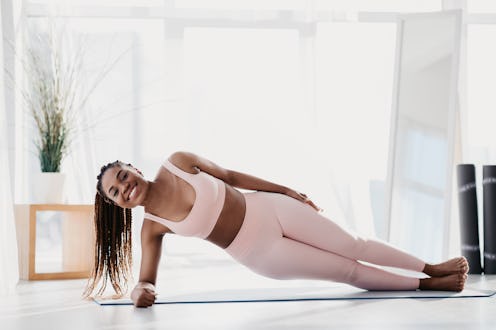
While a side plank sounds simple enough — just do a plank on your side, right? — maneuvering into position can be surprisingly difficult. It’s easy to tip forward or fall back, and even easier to modify the move incorrectly. But once you figure out how to do a side plank properly, you’ll find that it’s one of the best full-body moves you can do.
Planks — and all of their many variations — are typically referred to as staple core exercises, which is accurate, but there are usually other muscle groups working right alongside them. “A side plank is an incredibly efficient move that helps to strengthen your obliques, the stabilizing muscles in your hips — your gluteus medius and gluteus maximus — as well as the stabilizing muscles in your shoulders, or deltoids,” says Amanda Jenny, the founding instructor of bande. Add side planks to your routine, and you may find that they help improve your overall coordination and balance, Jenny adds, thanks to the way these muscle groups work together to hold you up.
According to fitness trainer Andy Stern, this unilateral move is also great for strengthening the posterior or back side of your abdominal wall. “Building these muscles up will play an important role in supporting your lower back and overall core strength,” he tells Bustle. “That, in turn, will help with daily posture and mobility.” If that sounds good to you, then read on to learn how to do a side plank properly — including how to modify it — so you can get the most of the move.
How To Do A Side Plank
Tanya Rockovich, a Club Pilates instructor, shares her tips for nailing the exercise in perfect form:
- Start by lying on your side.
- Prop up on your bottom arm, stacking your elbow underneath your shoulders.
- Extend your legs so your body forms a straight line.
- Inhale, then exhale and press into your forearm to lift up.
- Your weight will be on your forearm and bottom foot.
- Squeeze the side of your body to lift your hips.
- Engage your core and glutes to remain steady.
- Hold at the top of the movement for 30 seconds. Continue to breathe.
- Slowly lower back down and repeat on the other side.
How To Modify A Side Plank
If 30 seconds isn’t doable, start out by holding the exercise for 15, 10, or even 5 seconds to start. You can also modify the side plank position by dropping your bottom leg to the ground. Either bend it so your shin and ankle rest on the floor like a sort of tripod, or plant your top foot behind your calf, says Stern. This will take some pressure off your arms and core.
As you progress, you can make the move more difficult by increasing the time you hold the move. You can also challenge yourself by lifting your top leg into the air while keeping it parallel to your bottom leg, Stern says. This will further work your obliques as well as your hips and shoulders, which will have to engage to keep you steady.
For another advancement, straighten your bottom arm to do a “starfish.” It’ll take a lot of balance and core strength to hold yourself up. Rockovich also recommends adding movement: For example, lowering and lifting your top leg in a straight line for a couple of reps, she says, or doing a few side plank dips.
Common Side Plank Mistakes To Avoid
Whatever you do, don’t drop your hips or let them sag towards the floor as you hold a side plank. Avoid arching your back or dropping your head as well. To prevent injury (and get the most benefits out of the move), your body should remain in a straight line from the top of your head through to your feet without any areas bowing in or arching out.
“Side planks are challenging, so when your body starts to compromise by doing any of the above, take a break and reset,” Stern says. “Don't compromise form for added duration. Instead, work yourself up to longer intervals over time by doing more sets of shorter intervals.”
Since a side plank can exacerbate existing injuries, it’s also a good idea to stop if your shoulders, arms, or elbow start to hurt. “It is important to listen to your body and take the modifications necessary for yourself,” Rockovich says. While this exercise is meant to be challenging, it definitely shouldn’t be excruciating.
Studies referenced:
Akhtar, M. W., Karimi, H., & Gilani, S. A. (2017). Effectiveness of core stabilization exercises and routine exercise therapy in management of pain in chronic non-specific low back pain: A randomized controlled clinical trial. Pakistan journal of medical sciences, 33(4), 1002–1006. https://doi.org/10.12669/pjms.334.12664.
Örgün, E., Kurt, C., & Özsu, İ. (2019). The effect of static and dynamic core exercises on dynamic balance, spinal stability, and hip mobility in female office workers. Turkish journal of physical medicine and rehabilitation, 66(3), 271–280. https://doi.org/10.5606/tftrd.2020.4317.
Experts:
Amanda Jenny, founder, instructor at bande
Andy Stern, fitness trainer
Tanya Rockovich, Club Pilates instructor